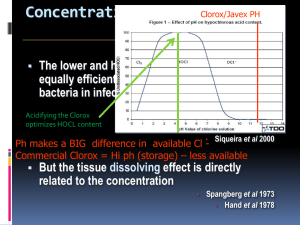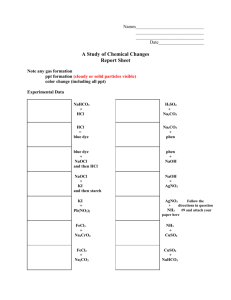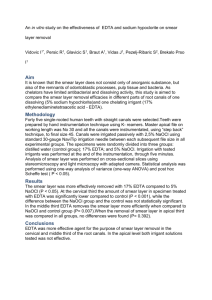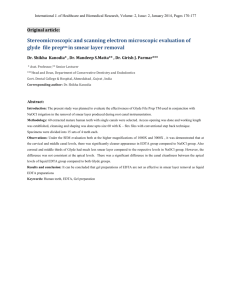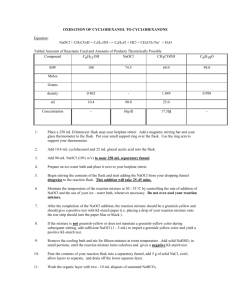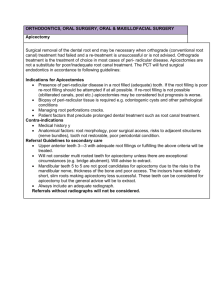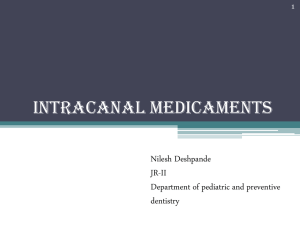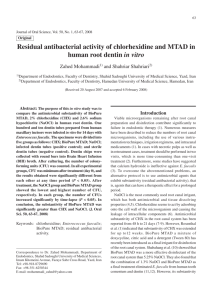Effect of MTAD on Enterococcus faecalis – Contaminated Root
advertisement
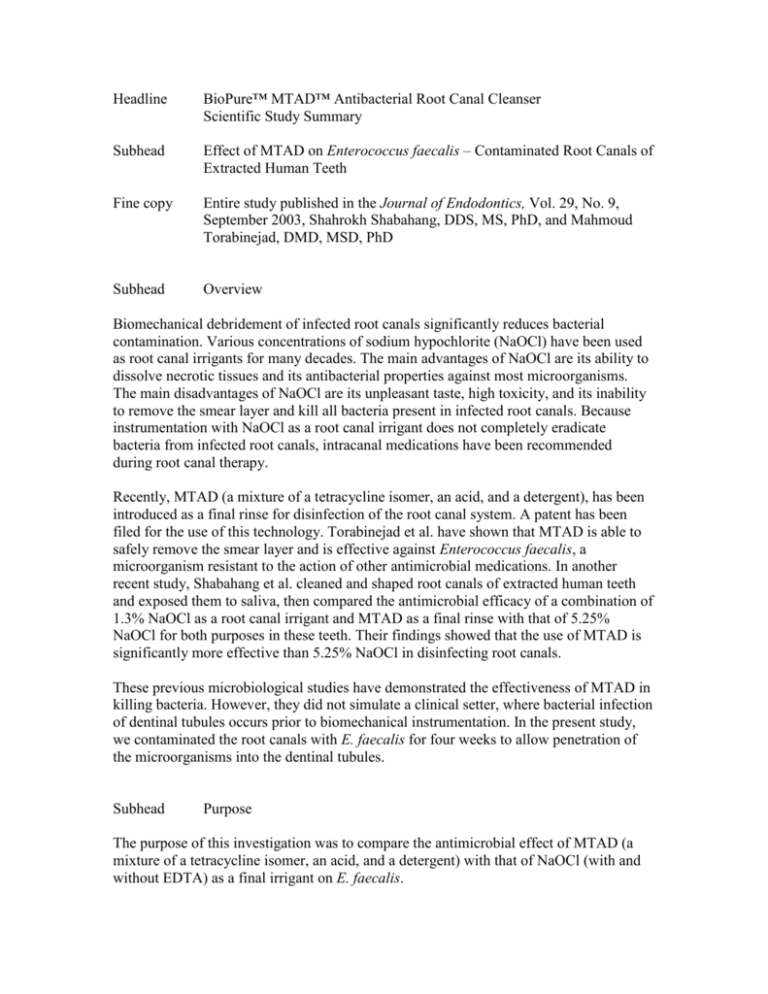
Headline BioPure™ MTAD™ Antibacterial Root Canal Cleanser Scientific Study Summary Subhead Effect of MTAD on Enterococcus faecalis – Contaminated Root Canals of Extracted Human Teeth Fine copy Entire study published in the Journal of Endodontics, Vol. 29, No. 9, September 2003, Shahrokh Shabahang, DDS, MS, PhD, and Mahmoud Torabinejad, DMD, MSD, PhD Subhead Overview Biomechanical debridement of infected root canals significantly reduces bacterial contamination. Various concentrations of sodium hypochlorite (NaOCl) have been used as root canal irrigants for many decades. The main advantages of NaOCl are its ability to dissolve necrotic tissues and its antibacterial properties against most microorganisms. The main disadvantages of NaOCl are its unpleasant taste, high toxicity, and its inability to remove the smear layer and kill all bacteria present in infected root canals. Because instrumentation with NaOCl as a root canal irrigant does not completely eradicate bacteria from infected root canals, intracanal medications have been recommended during root canal therapy. Recently, MTAD (a mixture of a tetracycline isomer, an acid, and a detergent), has been introduced as a final rinse for disinfection of the root canal system. A patent has been filed for the use of this technology. Torabinejad et al. have shown that MTAD is able to safely remove the smear layer and is effective against Enterococcus faecalis, a microorganism resistant to the action of other antimicrobial medications. In another recent study, Shabahang et al. cleaned and shaped root canals of extracted human teeth and exposed them to saliva, then compared the antimicrobial efficacy of a combination of 1.3% NaOCl as a root canal irrigant and MTAD as a final rinse with that of 5.25% NaOCl for both purposes in these teeth. Their findings showed that the use of MTAD is significantly more effective than 5.25% NaOCl in disinfecting root canals. These previous microbiological studies have demonstrated the effectiveness of MTAD in killing bacteria. However, they did not simulate a clinical setter, where bacterial infection of dentinal tubules occurs prior to biomechanical instrumentation. In the present study, we contaminated the root canals with E. faecalis for four weeks to allow penetration of the microorganisms into the dentinal tubules. Subhead Purpose The purpose of this investigation was to compare the antimicrobial effect of MTAD (a mixture of a tetracycline isomer, an acid, and a detergent) with that of NaOCl (with and without EDTA) as a final irrigant on E. faecalis. Subhead Materials and Methods Eighty-five extracted human teeth were contaminated with E. faecalis for four weeks. A single microorganism was used to contaminate the root canals to allow for ease of maintaining and accounting for a single species. The four-week infection period ensured adequate penetration of bacteria into the dentinal tubules. A smear layer was created using a combination of hand and rotary instrumentation techniques. The study then compared the protocol for disinfection of root canals using MTAD to four other regimens. The MTAD protocol for disinfection of root canals was developed on the basis of a pilot project that tested cleaning and shaping of root canals with 1.3% NaOCl as a root canal irrigant and exposure of these canals to 2 to 5 minutes of MTAD as a final irrigant. The results of this experiment showed that consistent disinfection of infected root canals occurs with this regimen when the exposure time to MTAD is five minutes. Once instrumented, the samples were divided into two control and five experimental groups. The canals of five instrumented teeth were irrigated with distilled water and served as positive controls. The canals of another five instrumented teeth were irrigated with distilled water and the teeth were autoclaved; these teeth served as the negative control samples and were subjected to the same microbiological sampling procedures. The remaining 75 teeth were divided into five groups of 15 teeth each. Using 1.3% or 5.25% NaOCl as a root canal irrigant, the root canal and the external surface of each tooth were exposed to a 5-minute application of the following: A. B. C. D. E. MTAD 1.3% NaOCl 5.25% NaOCl 1 minute application of EDTA followed by irrigation with 5 ml of 1.3% NaOCl 1 minute application of EDTA followed by irrigation with 5 ml of 5.25% NaOCl. Teeth or dentin shavings were cultured to determine the presence or absence of the test bacteria. Subhead Results Subhead Table 1. Effect of Various Disinfection Regimens on Enterococcus Faecalis – Contaminated Root Canals Treatment Negative controls Sample Size Growth 5 0 Growth with Shavings 0 Growth (Total) 0 Positive controls 5 5 5 Group A 15 0 0 Group B 15 6 2 Group C 15 7 1 Group D 15 6 1 Group E 15 5 3 Group A – 1.3% NaOCl irrigant, MTAD rinse, MTAD final application 5 0 8 8 7 8 None of the 15 samples in group A showed any growth after one week of incubation. Examination of the dentin shavings from these teeth demonstrated absence of any growth on BHI plates. Group B – 1.3% NaOCl irrigant, 1.3% NaOCl rinse, 1.3% NaOCl final application Six of 15 samples in group B demonstrated turbidity in the test tubes. When dentin shavings were obtained from the root canals of the remaining nine teeth in this group, two additional samples demonstrated presence of bacteria. Group C – 5.25% NaOCl irrigant, 5.25% NaOCl rinse, 5.25% NaOCl final application Seven of 15 samples in group C showed turbidity. One additional tooth from this group demonstrated presence of E. faecalis after examination of the dentin shavings from the roots of the remaining eight teeth. Group D – 1.3% NaOCl irrigant and exposure to 17% EDTA for 1 minute, 1.3% NaOCl rinse, 1.3% NaOCl final application Six of 15 teeth in group D caused turbidity in test tubes. When dentin shavings were cultured from the remaining nine samples in this group, one additional tooth was infected. Group E – 5.25% NaOCl irrigant and exposure to 17% EDTA for 1 minute, 5.25% NaOCl rinse, 5.25% final application Five of 15 teeth in group E demonstrated turbidity after one week in the BHI broth. When the dentin shavings from the remaining 10 roots were examined on BHI agar plates, an additional three teeth yielded growth in this group. Subhead Conclusion The results from the samples in the positive control group showed that debridement of root canals using distilled water is unable to sterilize the root canal system. The five samples in the negative control group, which were exposed to the identical microbiological steps as the teeth in the experimental groups, demonstrated that contamination did not occur during the culturing procedures. Absence of growth on the BHI plates using dentin shavings from this group confirmed that contamination did not occur during preparation of the shavings. The ineffectiveness of NaOCl to consistently disinfect root canals in this study is in agreement with results from previous investigations. This finding is especially true with E. faecalis, which is a bacterium that is known to resist the antibacterial effects of certain root canal medicaments. Although presence of smear layer prevents penetration of antibacterial agents into the dentinal tubules, study results showed that removal of the smear layer with a one-minute rinse of 17% EDTA did not enhance the antimicrobial properties of NaOCl. The lack of increased antimicrobial efficacy may be due to the inability of NaOCl to remove the smear layer, its inability to penetrate into the dentinal tubules once the smear layer has been removed, or its ineffectiveness in killing E. faecalis. Findings also showed that removal of smear layer with a chelating solution (EDTA) that has little or no antibacterial effect, does not enhance the antibacterial effect of NaOCl. Fisher’s exact test showed that the combination of 1.3% NaOCl as a root canal irrigant and MTAD as a final rinse was significantly more effective against E. faecalis than the other regimens. The x2 test showed no difference between the other regimens. On the basis of these results, it appears that MTAD is an effective final rinse for eradication of E. faecalis from extracted human teeth.
